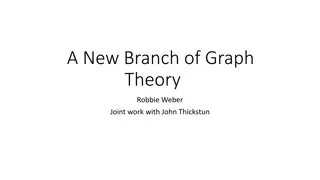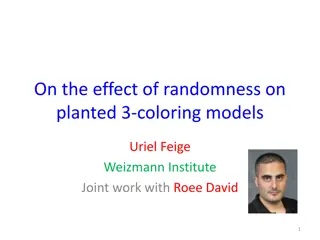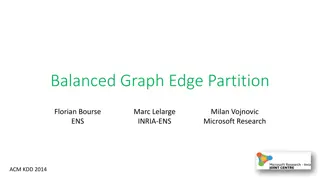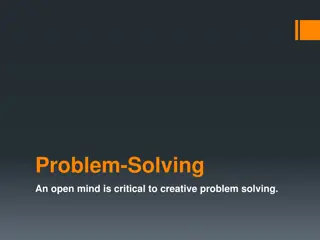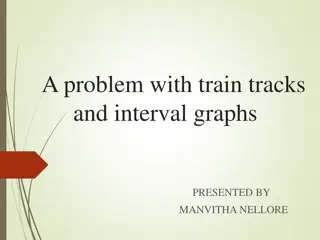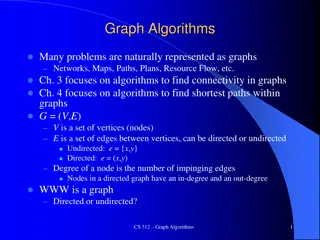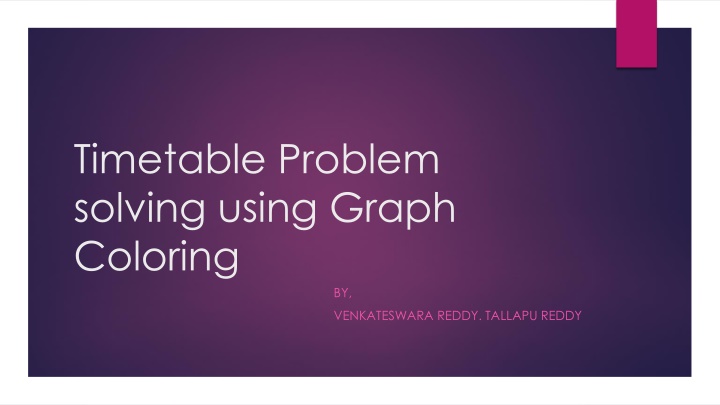
Solving Timetable Problems using Graph Coloring Techniques
Explore how graph coloring can be applied to solve timetable problems efficiently. Understand the problem statement, graph construction, graph coloring concepts, and their application in real-world scheduling challenges. Discover how to minimize time slots while allocating activities to resources effectively.
Uploaded on | 0 Views
Download Presentation

Please find below an Image/Link to download the presentation.
The content on the website is provided AS IS for your information and personal use only. It may not be sold, licensed, or shared on other websites without obtaining consent from the author. If you encounter any issues during the download, it is possible that the publisher has removed the file from their server.
You are allowed to download the files provided on this website for personal or commercial use, subject to the condition that they are used lawfully. All files are the property of their respective owners.
The content on the website is provided AS IS for your information and personal use only. It may not be sold, licensed, or shared on other websites without obtaining consent from the author.
E N D
Presentation Transcript
Timetable Problem solving using Graph Coloring BY, VENKATESWARA REDDY. TALLAPU REDDY
Outline What is Timetable problem..? Problem Statement. How to construct a graph for this Real-World problem..? What is Graph Coloring..? How graph coloring can solve this RW problem..? Is it NP-hard or not..? References.
What is Timetable Problem..? Timetable problem can be seen as a form of scheduling where the task is to allocate activities to available slots within resources respecting some constraints. There has been a lot of algorithms developed for this particular problem using different techniques like Graph Coloring, Tabu Search, Genetic Algorithm, Optimization problem and so on.. This is a problem with so many variations due to various constraints that can be tied to it.
Problem Statement. Design a simple class schedule with no conflict between a set of teachers and a set of courses with the following set of constraints: 1. No same courses can be taken by any teacher or batch for a given time slot. 2. Minimize the number of time slots required and prove that it is optimum.
How to construct a Graph for this RW Problem..? For example, let us consider 5 courses needed to be scheduled without any conflicts. Then how we can represent them in a graph is as shown below Graph representation Vertices: represents courses Edges: represents a pair of courses that conflict, and a Color: represents the period in which that particular course is to be scheduled.
What is Graph Coloring..? Vertex coloring : It is a way of coloring the vertices of a graph such that no two adjacent vertices share the same color. Edge coloring : An edge-coloring of G is a mapping f : E(G) S. The element of S are colors; the edges of one color form a color class. If |S| = k, then f is a k-edge coloring. Chromatic Number: = least number of colors needed to color a graph.
How graph coloring can solve this RW problem..? Let us consider an example, In a college there are m professors x1, x2, , xmand n subjects y1, y2, , ynto be taught. Given that professor xiis required to teach subject yjfor pijperiods. Construct a bipartite multigraph G with vertices x1, x2, , xm, and y1, y2, , ynsuch that vertices xiand yjare connected by pijedges. Initially consider a single period. The timetable for this single period corresponds to a matching in the graph and, conversely, each matching corresponds to a possible assignment of professors to subjects taught during this period. Thus, the solution to the timetabling problem consists of partitioning the edges of G into the minimum number of matching's. Equivalently, we must properly color the edges of G with the minimum number of colors.
Contd. We shall show yet another way of solving the problem using the vertex coloring algorithm. Recall that the line graph L(G) of G has as vertices the edges of G and two vertices in L(G) are connected by an edge if and only if the corresponding edges in G have a vertex in common. The line graph L(G) is a simple graph and a proper vertex coloring of L(G) yields a proper edge coloring of G using the same number of colors. Thus, to solve the timetabling problem, it needs to find a minimum proper vertex coloring of L(G).We demonstrate the solution with a small example.
Suppose there are four professors x1, x2, x3, x4and five subjects y1, y2, y3, y4, y5to be taught. The teaching requirement matrix p = [ pij] is as shown: p y1 y2 y3 y4 y5 x1 2 0 1 1 0 x2 0 1 0 1 0 x3 0 1 1 1 0 x4 0 0 0 1 1 The bipartite multi graph G
Vertex Coloring: (1, green), (2, red), (3, blue), (4, yellow), (5, yellow), (6, green), (7, green), (8, yellow), (9, red), (10, blue), (11, yellow). This, in turn, yields a minimum proper vertex 4-coloring of the bipartite multigraph G: 3 2 4 1 5 11 6 10 7 8 9
Edge Coloring: ({x1, y1}, green), ({x1, y1}, red), ({x1, y3}, blue), ({x1, y4}, yellow), ({x2, y2}, yellow), ({x2, y4}, green), ({x3, y2}, green), ({x3, y3}, yellow), ({x3, y4}, red), ({x4, y4}, blue), ({x4, y5}, yellow). Then, from the edge coloring of G, we obtain a solution of the given timetabling problem as shown below: - 1 2 3 4 x1 x2 x3 x4 y1 y4 y2 - y1 - y4 - y3 - - y4 y4 y2 y3 y5 Consider green, red, blue, yellow as periods 1, 2, 3, 4 respectively.
Is it NP-hard or not..? Timetable problem solving has many variations due to various constraints that can be tied to it. That is why it is so hard and is considered as NP(Non-Polynomial) complete. i.e. it does not have any polynomial time bound. However, approximate algorithm or heuristic approach can be taken to attain solution in a feasible time bound
References. http://www.iro.umontreal.ca/~hahn/IFT3545/GTWA.pdf http://www.hoonzis.com/applications-of-graph-theory/ http://www.cs.xu.edu/csci390/12s/IJEST10-02-09-124.pdf






